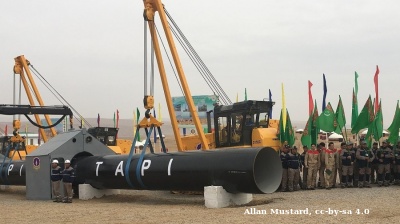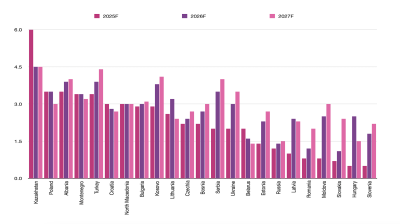Russia has been eagerly pushing for the further development of Turkey as a “gas hub” for its gas supplies to Europe. Analysts are asking if this simply a ruse to dodge sanctions and surreptitiously continue to export gas to EU members that are trying to wean themselves off their Russian dependency. Many EU members have pledged to stop importing Russian supplies altogether over the coming years.
Russian President Vladimir Putin proposed establishing Turkey as a hub for delivering gas supplies to the EU in October, after explosions destroyed three of the four strands of the Nord Stream gas pipelines that run under the Baltic Sea on September 26.
Russia has few other remaining options to send gas to Europe. Sanctions and counter-sanctions imposed by Russia and Poland have prevented any westward flow of Russian gas to Central Europe via the 33bn cubic metre per year Yamal-Europe pipeline that transverses Poland to Europe.
Meanwhile, Russia’s ongoing war in Ukraine means that the cutting off of Russian gas transit via that 100 bcm per year route is a constant risk. That leaves only the 31.5 bcm per year TurkStream pipeline that runs under the Black Sea to Turkey as a functioning transport route, although only half of this capacity is used to pump gas to Europe, while the remainder is dedicated to the Turkish market.
Russia has proposed adding two more strings to TurkStream, in order to double its capacity. The Turkish market itself is already saturated but Turkey enjoys not only access to Azeri and Iranian piped gas, but also LNG. And the country is targeting first production from the offshore Sakarya field in 2024, which is expected to cover its growing gas demand for years to come. Turkey could in theory feed all of Europe with Russian, Azerbaijani and Iranian gas entering the European pipeline system from the south-east of the Continent.
Moscow has made no secret about its ambitions. The Kremlin wants to send Russian gas to Turkey for onward transport to Europe. As more and more EU member states and companies are expected to phase out Russian gas over the coming years, the Russian plan appears to be to sell supplies to Turkey that could then be resold to European buyers. Once in the grid, after all, gas molecules are indistinguishable. And deciding how much of the gas that Europe takes from Turkey has a Russian origin would be hard to do. For example, Ukraine stopped importing gas from Russia years ago and sources much of its imports from Poland and Slovakia; however, that gas is ultimately Russian in origin.
The gas hub plan is still in its infancy and would take years to develop. Neither Moscow nor Ankara have commented on an exact timeframe, nor a cost estimate for the extensive new pipeline infrastructure that would be required. But the original TurkStream cost roughly $12bn, giving an idea of the expense it would take to double its capacity to 63 bcm per year.
TurkStream was originally envisaged with a capacity on the order of 60 bcm, but Moscow decided to halve its capacity in October 2015, as Turkey had expressed less interest in taking as much Russian gas as was originally planned. Months earlier Gazprom and its European partners had also unveiled the Nord Stream 2 plan, which was considered a better route for sending more gas to Europe, particularly as it was expected to strengthen energy ties with Germany without having to rely on a transit country.
Using Azerbaijan, Russia would be hard-pressed to develop a new and costly expansion of TurkStream in light of its economic isolation by the West – strained access to international financing being a key hurdle. But Moscow may also be hoping that the EU does the work for it.
European Commission President Ursula von der Leyen personally travelled to Baku in July to sign a deal that doubles Azerbaijan’s gas deliveries to Europe. The EU is asking to purchase 20 bcm per year by 2027. Doing so would require further upstream development in the Caspian Sea, and the expansion of the Southern Gas Corridor (SGC) pipeline network that runs through Turkey to Southern Europe.
While the Brussels-Baku deal is aimed at replacing Russian gas supply, it may also present Moscow with an opportunity. While Azerbaijan is a net exporter of gas, it also struggles with a domestic gas supply squeeze, as the government has long prioritised the sale of its gas overseas over home needs, in order to maximise export revenues. This means that when Gazprom announced in November it was restarting gas exports to Azerbaijan to help cover domestic demand that raised eyebrows in Brussels.
Gazprom was a supplier of gas to Azerbaijan between 2000 and 2006, but then the country rapidly expanded its own gas production at the BP-operated Shah Deniz field, allowing it not to only cover its own gas needs but export supplies to Georgia and Turkey. With much of its gas contracted to foreign buyers, Azerbaijan then turned back to Russian supplies in 2017-2018, only to cease purchases again after the second stage of Shah Deniz’s development flowed its first gas in 2019. And then in mid-November this year, Gazprom announced it would once again resume gas deliveries to Azerbaijan – some 1 bcm between now and March to cover peak winter demand.
Russia could therefore sell more gas to Azerbaijan, covering as much of its domestic demand as possible, and this in turn would free up more volumes for Azerbaijan to send to the EU – effectively Russia would sell gas to the EU through the back door. This would undermine EU efforts to deprive Russia of global gas market share – the gas would simply be sold somewhere else.
Russia has been running a similar scheme with the Kingdom of Saudi Arabia (KSA): Russia sells crude to the kingdom, which the latter refines for its domestic needs, freeing up more of its own non-sanctioned crude to export to customers in the West.
While a strategy of selling more gas to Azerbaijan, and using Turkey as a conduit for continued, but indirect gas supplies to Europe, would be a logical response by Moscow to the EU’s commitment to severing energy ties with Russia, but it also carries risks.
First, it would put Turkey in a highly advantageous position, capable of cutting off large volumes of Russian gas supply to Europe in the event of a break in relations between the two countries. Russia and Turkey have at times had an uneasy relationship – most notably in late 2015, when the Turkish air force shot down a Russian fighter jet flying close to the Syria-Turkey border. The two sides reached a rapprochement the following years.
There is also the added cost of transiting gas through Turkey. This is what made the Nord Stream 1 and 2 pipelines such a desirable option for Russia – the absence of transit fees. If Russian gas was sold to Europe via Turkey in a covert way, then the transit fee would take the form of Turkey buying the gas at a below-market rate, for onward sale at a higher price.
Meanwhile, the Azeri gas market will not offer Russia the same returns as Europe provided.
Faced with what is likely the irrevocable loss of most of its market share in Europe, however, these may be the best options for Moscow to pursue, particularly as it will take much longer for Russia to develop extra infrastructure to send gas that would otherwise have gone to Europe to China and other Asian markets.
Features

Turkmenistan’s TAPI gas pipeline takes off
Turkmenistan's 1,800km TAPI gas pipeline breaks ground after 30 years with first 14km completed into Afghanistan, aiming to deliver 33bcm annually to Pakistan and India by 2027 despite geopolitical hurdles.

Looking back: Prabowo’s first year of populism, growth, and the pursuit of sovereignty
His administration, which began with a promise of pragmatic reform and continuity, has in recent months leaned heavily on populist and interventionist economic policies.

Emerging Europe’s growth holds up but risks loom, says wiiw
Fiscal fragility, weakening industrial demand from Germany, and the prolonged fallout from Russia’s war in Ukraine threaten to undermine growth momentum in parts of the region.

The man who sank Iran's Ayandeh Bank
Ali Ansari built an empire from steel pipes to Iran's largest shopping centre before his bank collapsed with $503mn in losses, operating what regulators described as a Ponzi scheme that poisoned Iran's banking sector.




